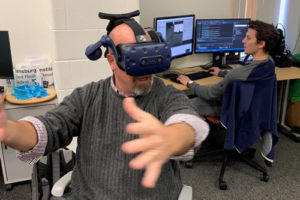Dillon Cutaiar will graduate Virginia Tech in May 2020 with a job at Microsoft in his back pocket, thanks to his virtual and augmented reality work in the University Libraries at Virginia Tech.
Augmented reality adds digital elements, like Snapchat filters or holograms, to live experiences seen through smartphones, iPads, or other devices. Virtual reality typically uses goggles and immerses the wearer in an alternate experience that shuts out the physical world.
Related content: 5 ways augmented reality apps are changing the game
During Cutaiar’s two-year paid fellowship with Todd Ogle in University Libraries Applied Research in Immersive Environments and Simulations, the computer science major freely took chances and pushed boundaries in virtual and augmented reality research.
He began with single-handedly fixing a project that preserves the history of Christiansburg Institute – an African American school once run by Booker T. Washington and located in Christiansburg, Virginia.
“Dillon’s work on the Christiansburg Institute project is the sole reason it exists today. He made the tough call and told me a complete rewrite would be necessary,” said Ogle. “That showed maturity. He single-handedly took my design requirements and bootstrapped the app from scratch.”
Through an iPad loaded with an app, students stroll school grounds, explore buildings that no longer exist, investigate original school photographs, and build their own historical record of the school that educated the region’s African American students from 1870-1966.
Cutaiar didn’t have previous experience with the program used to build the project — but he took advantage of library resources and expertise to learn it. “I was ready to learn whatever I needed to. I had to take full ownership of the project and Todd had a lot of trust in me,” said Dillon.
He then expanded his projects to include a virtual version of the School of Performing Arts’ and the Institute for Creativity, Arts, and Technology’s installation Shakespeare’s Garden, an immersive sound stroll through Shakespeare’s sonnets, soliloquies, and scenes in the Moss Arts Center’s Cube.
“I made it work from scratch by bringing in visuals and audio from original artists and a virtual model of the Cube from graduate student Lucas Freeman in the School of Visual and Performing Arts,” said Cutaiar.
“I created a similar virtual reality preservation of the School of Visual Arts and School of Performing Arts’ Poe’s Shadows: An Immersive Theatrical Installation. It’s a mobile experience of the giant rotating Tell-Tale Heart illustration. Virtual reality can preserve a unique experience and make it available beyond the original installation.”
Ogle provides students experience in working with the latest technology, researching innovative virtual reality practices, and experimenting in emerging technologies as members of multidisciplinary faculty and student teams.
“Students apply skills they may be exposed to through coursework but not have adequate time to master them,” said Ogle. “They also stretch their skills and add new ones to their personal toolkit through problem-solving and peer teaching.”
Cutaiar’s most exciting fellowship experience was traveling to the Smithsonian Institution’s National Museum of American History as part of the 2019 ACCelerate festival. Cutaiar and faculty from several disciplines across the university created a virtual and physical exploration of Vauquois, France’s WWI tunnels. It included a physical replica of the tunnel that seamlessly integrated with the virtual experience.
In the exhibit, visitors experience how soldiers lived and fought in these tunnels with rough walls, dim light, and no privacy while explosives knock pebbles from the ceiling. They came away with empathy for the soldiers’ plight and a deeper knowledge of WWI history.
“It’s fulfilling to build projects that make a difference in learning and the way people view the world,” said Cutaiar. “My work in the library is the main reason I know what I want to do. The technical skills I have in augmented reality, certain programming languages, and my experience working in diverse teams got me my job at Microsoft. It was really helpful for me.”
At Microsoft, Cutaiar will be working on projects similar to those he created at the library. He will overlay digital elements, such as objects, videos, and graphics, on a live view to help train front-line employees in manufacturing or other hands-on professions.
“Holograms used to be science fiction, but now they are becoming a reality. I’m excited about my future because I’m confident in my ability to learn new things,” said Dillon. “With Todd, I learned how to be comfortable with the ambiguity inherent in creation and innovation — I’m thankful for that.”
[Editor’s note: This story originally appeared on Virginia Tech Daily and is reposted here with permission.]

